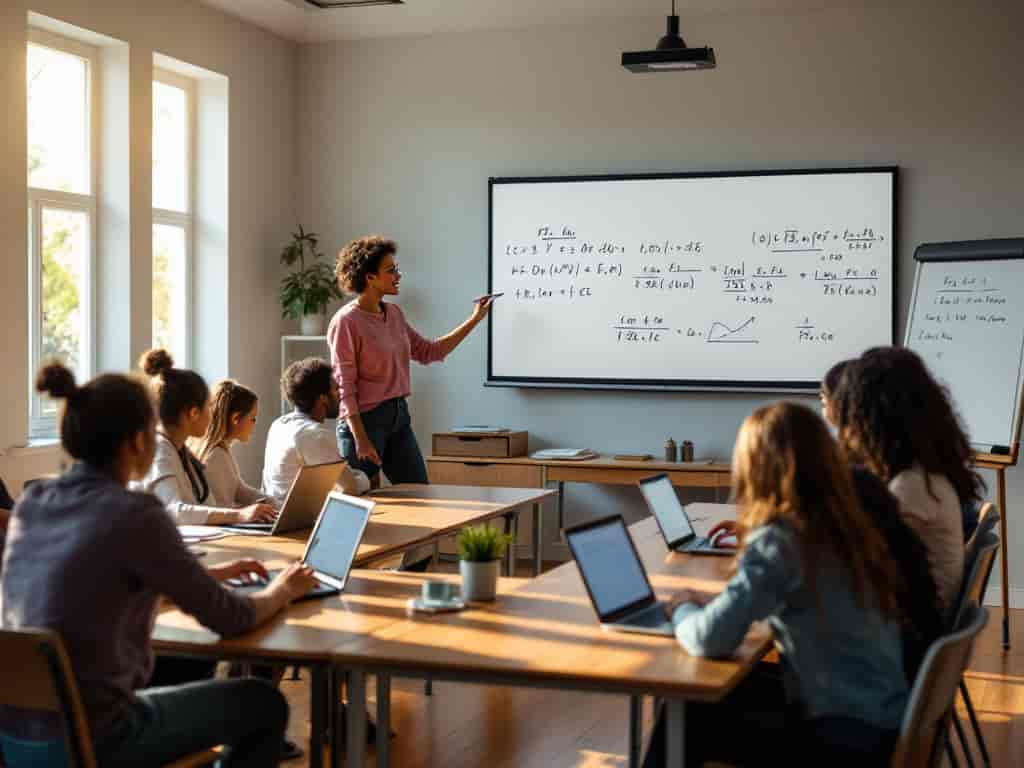Flipped Classrooms: How They Boost Student Learning
Ellie Moore

Photo: Flipped Classrooms: How They Boost Student Learning
Flipped Classrooms: How They Boost Student Learning
In today's fast-paced educational landscape, traditional teaching methods are being increasingly challenged. Among the innovative approaches gaining traction is the flipped classroom model, which is revolutionizing how students learn and interact with course materials. This article delves into what a flipped classroom is, how it functions, and most importantly, how it boosts student learning outcomes.
What is a Flipped Classroom?
A flipped classroom is an instructional strategy where the typical learning environment is "flipped." In a traditional classroom, teachers deliver lectures during class time, and students complete assignments or homework outside of class. However, in a flipped classroom, the sequence is reversed: students watch pre-recorded lectures, read materials, or engage in online discussions before coming to class. Class time is then dedicated to active learning activities like discussions, group projects, or problem-solving exercises.
This approach allows teachers to maximize face-to-face interaction with students, focusing on applying knowledge rather than simply delivering content. It leverages technology to facilitate learning and makes the educational experience more student-centered.
The Key Benefits of Flipped Classrooms for Student Learning
Flipped classrooms are more than just a trendy educational buzzword. Research and real-world case studies have shown that they offer a wide range of benefits for students, from increased engagement to improved retention and higher academic performance. Let's break down these advantages:
1. Promotes Active Learning
One of the core principles of flipped classrooms is active learning. Instead of passively receiving information from a lecture, students are encouraged to interact with the content before class. This can include watching video lectures, reading articles, or completing quizzes that assess their understanding.
Once in class, the focus shifts to applying knowledge through collaborative activities, discussions, or practical exercises. This hands-on approach helps students better retain information and develop critical thinking skills, which are often lacking in traditional lecture-based learning.
2. Supports Self-Paced Learning
Flipped classrooms provide students with the flexibility to learn at their own pace. Whether they need to rewatch a lecture to fully grasp a concept or spend extra time reviewing a difficult topic, students can tailor their learning experience to fit their individual needs.
This self-paced model is particularly beneficial for diverse learners students who may need more time to understand certain concepts or those who may already grasp the material and wish to move ahead.
3. Encourages Collaboration and Peer Learning
With more time spent engaging in classroom activities, flipped classrooms foster a collaborative learning environment. Students work in groups, solve problems together, and often teach one another. This peer interaction not only reinforces the material but also helps students develop important social and communication skills.
Studies show that collaborative learning is highly effective in improving problem-solving skills and deepening understanding. When students explain concepts to each other, they reinforce their own knowledge while learning from diverse perspectives.
4. Improves Student Engagement
Flipped classrooms tend to increase student engagement by making learning more interactive and enjoyable. Traditional lectures can often be monotonous and disengaging, while flipped classrooms allow for a more dynamic approach where students can engage in activities that are relevant to their learning goals.
With the integration of multimedia resources, online quizzes, and collaborative tools, flipped classrooms help students connect with the material in a way that is both fun and educational. Teachers can also customize content to cater to the learning styles of their students, further enhancing engagement.
5. Promotes Better Retention of Information
Research has shown that students in flipped classrooms tend to retain information for a longer period compared to those in traditional classrooms. The reason? Active learning and the ability to review content at their own pace lead to better long-term memory retention.
In flipped classrooms, the focus is on deep learning rather than surface-level memorization. By applying concepts during class activities and discussions, students are able to internalize the information and relate it to real-world scenarios, which strengthens their memory.
How Does the Flipped Classroom Work in Practice?
Implementing a flipped classroom requires careful planning and the integration of technology. Here's a step-by-step breakdown of how flipped classrooms typically function:
1. Preparation Before Class
Before attending class, students are assigned a variety of materials such as:
- Video lectures: Pre-recorded lessons by the instructor covering key concepts.
- Readings: Assigned chapters or articles that introduce the topic.
- Interactive quizzes: These assessments help gauge student understanding and highlight areas for further focus.
2. Classroom Activities
In the classroom, the teacher shifts from being the central figure delivering information to a facilitator who guides students in applying what they’ve learned. Typical classroom activities include:
- Problem-solving: Students work on exercises that require them to apply the concepts they studied.
- Group discussions: Students collaborate to explore different viewpoints and solve problems.
- Peer teaching: Students explain concepts to each other, reinforcing their understanding.
3. Assessment and Feedback
In a flipped classroom, assessments are ongoing and often focus on formative feedback. Teachers can monitor student progress through interactive tools, quizzes, and class participation. Feedback is immediate, allowing for adjustments in teaching and learning strategies if necessary.
Real-Life Examples of Successful Flipped Classrooms
Numerous schools and universities around the world have successfully implemented flipped classrooms. For instance:
- The University of Michigan: Used flipped classrooms to enhance their engineering courses. By shifting lectures online, students were able to spend more time working on complex problem sets and engaging in real-world projects. As a result, the university saw a noticeable improvement in both student engagement and performance.
- The Flipped Learning Network: An international organization that supports flipped learning, has highlighted several schools that reported increased student engagement and test scores after switching to the flipped classroom model.
Overcoming Challenges in Flipped Classrooms
While flipped classrooms offer many advantages, they also present certain challenges. Teachers may face difficulties in creating engaging, high-quality video content, or students may struggle with self-paced learning if they lack time management skills.
To mitigate these issues, consider the following:
- Start Small: Begin by flipping just one lesson or unit and gradually increase the use of the model as you gain confidence.
- Provide Clear Instructions: Ensure students understand how to access and engage with materials before class.
- Encourage Accountability: Use tools like quizzes or peer assessments to keep students on track and hold them accountable for their learning.
Conclusion: The Future of Education
Flipped classrooms represent a transformative approach to education that not only makes learning more engaging but also empowers students to take charge of their own education. By incorporating technology and active learning, teachers can foster a classroom environment that promotes collaboration, deeper understanding, and improved student outcomes.
As this model continues to gain popularity, educators will likely discover even more innovative ways to harness its power. Whether you’re a teacher looking to enhance your students' learning experience or a student eager to take control of your educational journey, the flipped classroom is undoubtedly a trend worth exploring.
Call to Action: Have you experienced a flipped classroom in your learning journey? Share your thoughts in the comments below! If you're a teacher considering the flipped model, feel free to ask questions or share your experiences.
FAQ: Common Questions About Flipped Classrooms
Q1: Do flipped classrooms require a lot of technology? A1: While technology is often used in flipped classrooms, it’s not an absolute necessity. You can start with simple tools like recorded lectures or assigned readings. However, to get the most out of a flipped classroom, it's helpful to integrate interactive technology.
Q2: Is the flipped classroom model suitable for all subjects? A2: Yes! While it's particularly effective in subjects like math, science, and engineering, flipped classrooms can be adapted for nearly any subject. The key is to create interactive and engaging materials that promote active learning.
Q3: How do I manage students who are not motivated to complete pre-class activities? A3: Clear communication is key. Set expectations and use formative assessments like quizzes to hold students accountable. You can also gamify the process to make the pre-class work more engaging.
Finance & Investment
View All
November 16, 2024
Top 5 Budgeting Apps That Will Save You Money InstantlyDiscover the top budgeting apps that will transform your financial life! Learn how these apps can help you track expenses, save money, and achieve your financial goals. Download now and start saving!
Ellie Moore

November 14, 2025
What Is Finance and ManeuverMaster expert SEO content to build authority, boost rankings, and future-proof your strategy. Learn to create valuable, E-E-A-T-driven information.
Ellie Moore

October 11, 2025
Decentralized Finance Future of MoneyMaster expert SEO content to boost rankings, traffic, and brand authority. Learn what it is, why it's crucial, and how to create it for online success.
Ellie Moore

November 6, 2025
Bible Verses That Inspire FinancesGo beyond keywords! Discover how expert SEO content, built on E-E-A-T, delivers real value, builds trust, and establishes your online authority.
Ellie Moore

April 21, 2025
Yahoo Finances Made SimpleYour guide to dominating search in 2025! Discover how expert SEO content, built on E-E-A-T, drives authority, trust, and top rankings.
Ellie Moore

April 5, 2025
Side Hustles: Build Wealth & Achieve Financial FreedomDiscover how side hustles can create a steady income stream. Learn practical ways to earn extra money and work toward financial independence!
Ellie Moore
Insurance
View AllExplore how InsurTech startups are transforming the insurance industry with innovation and cutting-edge solutions.
Ellie Moore
Discover how peer-to-peer insurance models operate, offering community-based risk-sharing alternatives.
Ellie Moore
Unlock optimal coverage & financial security with Premium Marketplace Health Insurance. A guide for agents, policyholders & risk managers to make informed choic...
Ellie Moore
Save on health insurance without losing essential coverage. Discover practical tips to reduce premiums and manage costs wisely.
Ellie Moore
Protect your most valuable asset! This guide reveals how to find the Top-Rated Best Home Insurance for unparalleled security and peace of mind.
Ellie Moore
Master Essential Direct Auto Insurance to cut costs, optimize coverage, and boost financial security. A must-read for policyholders, risk managers & agents.
Ellie Moore
Education
View AllGPKP kritik keras Dinas TPH&Nak Musi Rawas soal transparansi pupuk bersubsidi. Penutupan data publik dinilai langgar UU KIP dan merugikan hak petani kecil.
Read MoreLearn effective classroom strategies to manage ADHD. Discover how teachers can support students with ADHD for better learning outcomes.
Read MoreThe digital divide limits education access. Explore strategies and initiatives to bridge this gap and ensure global learning equality.
Read MoreDifferent cultures approach early education in unique ways. Discover how cultural values shape learning practices for young children around the world.
Read MoreArts education is key to fostering creativity. Learn why it’s important in schools and how it helps students develop essential life skills.
Read MoreShould smartphones be allowed in classrooms? Explore the pros and cons of using smartphones in education and their impact on learning.
Read MorePopular Post 🔥
View All
1
2
3
4
5
6
8
9
10
Health






Automotive
View All
July 30, 2025
Anything Automotive You Should Know Today
The automotive world is shifting! Learn about EVs, charging, and new tech to make smarter driving decisions for your wallet and the planet.

July 17, 2025
JT Automotive Services Worth Checking Out
Unlock peace of mind & vehicle longevity. Discover why choosing the right car care partner, like JT Automotive Services, truly matters.

August 5, 2025
Better Business Bureau Wiygul Automotive Burke Review
Searching for a reliable auto repair in Burke, VA? Explore Wiygul Automotive's BBB review & understand how BBB ratings ensure you find a trusted mechanic.

July 26, 2025
Gary's Automotive Tips For Smooth Driving
Unlock the secrets to truly smooth driving with Gary's expert tips! Boost safety, efficiency & extend your car's life.

August 20, 2025
Bills Automotive Affordable Local Car Care
Bills Automotive offers affordable, reliable local car care. Break the myth that quality service is expensive & save on auto maintenance.

February 5, 2025
Must-Have Tools for Every DIY Mechanic
Are you a DIY mechanic? Equip yourself with these essential tools for hassle-free car repairs and maintenance. See what every toolbox needs!

















